
Dendrobates is a genus of poison dart frogs native to Central and South America. It once contained numerous species, but most originally placed in this genus have been split off into other genera such as Adelphobates, Ameerega, Andinobates, Epipedobates, Excidobates, Oophaga, Phyllobates and Ranitomeya, leaving only five large to medium-sized species in the genus Dendrobates. All the other genera used to be grouped in with Dendrobates because it was previously thought that all brightly colored poison dart frogs came from the same ancestor but this has since been proven to be incorrect. Dendrobates and Phyllobates evolved conspicuous coloration from the same common ancestor but not the same as any of the other genera listed above.
Indirana tenuilingua is a species of frog that is considered nomen inquirendum. It is only known from the type series, now lost, from its type locality, Kemphole, in the Western Ghats of India. It is sometimes known as Rao's Indian frog or slender-tongued frog.
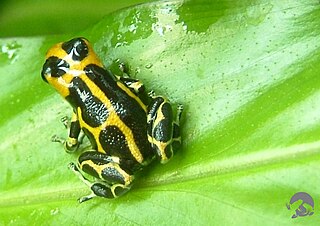
Ranitomeya imitator, is a species of poison dart frog found in the north-central region of eastern Peru. Its common names include mimic poison frog and poison arrow frog, and it is one of the best known dart frogs. It was discovered in the late 1980s by Rainer Schulte who later split it up into more subspecies; describing each as a specific color morph, and sometimes having a separate behavioral pattern. The acoustics, morphs, and behavior of the species have been extensively researched.
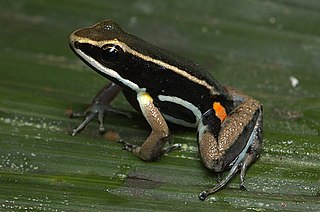
The Aromobatidae are a family of frogs native to Central and South America. They are sometimes referred to as cryptic forest frogs or cryptic poison frogs. They are the sister taxon of the Dendrobatidae, the poison dart frogs, but are not as toxic as most dendrobatids are.
Hyloxalus bocagei is a species of frog in the family Dendrobatidae. It is found on the northeastern side of the Andes in Ecuador and in Colombia. The specific name bocagei honors José Vicente Barbosa du Bocage, a Portuguese zoologist. Common name Bocage's rocket frog has been coined for this species.
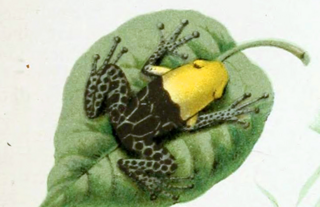
The red-headed poison frog is a species of frog in the family Dendrobatidae. It is endemic to Peru and found in the northern San Martín and Loreto Regions.
Ranitomeya flavovittata is a species of frog in the family Dendrobatidae. It is endemic to Peru and known with certainty only from the Loreto Region where its type locality is.

The blue-bellied poison frog or bluebelly poison frog is a species of frog in the family Dendrobatidae.

Ranitomeya vanzolinii, also known as the Brazilian poison frog or spotted poison frog, is a species of frog from the family Dendrobatidae. It is found in the Amazonian rainforests of Brazil and Peru, and possibly Bolivia.

Andinobates virolinensis is a species of frog in the family Dendrobatidae. It is endemic to Colombia where it is confined to the Santander and Cundinamarca departments on the Cordillera Oriental.
Atopophrynus is a genus of frogs. It is monotypic, being represented by a single species, Atopophrynus syntomopus, also known as the Sonson frog. Its taxonomic placement within the superfamily Brachycephaloidea is uncertain, although many sources place it in the family Craugastoridae. It is endemic to Colombia and only known from its type series from Sonsón, in the Cordillera Central, Antioquia Department.
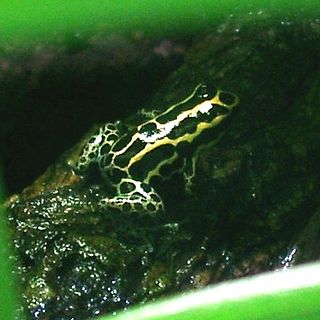
Ranitomeya is a genus of dart poison frogs found in Panama and South America south to Peru and Brazil, possibly into Bolivia.

Ranitomeya amazonica is a poison dart frog in the genus Ranitomeya. It was first described by Rainer Schulte in 1999 as Dendrobates amazonicus when he separated it from Dendrobates ventrimaculatus, primarily on the basis of call characteristics. The validity of the species has been debated, but further studies, also including genetic data, support its validity.

Dendrobatinae is the main subfamily of frogs in the family Dendrobatidae, the poison dart frogs of Central and South America, found from Nicaragua to the Amazon basin in Brazil.
The Rockstone poison dart frog is a poorly known species of dendrobatid frogs endemic to Guyana. As it is known from only one specimen, very little information is currently available on D. nubeculosus. It has been suggested to be one of the most poorly known species in the world.

Andinobates is a genus of poison dart frogs from Ecuador, Colombia and Panama. It contains species formerly classified in the genus Dendrobates and in 2006 transferred to the genus Ranitomeya. In 2011 Twomey, Brown, and their colleagues erected the genus Andinobates for a group of 12 species of Ranitomeya. Andinobates frogs can be distinguished from their sister taxon Ranitomeya anatomically in that their 2nd and 3rd vertebrae are fused. They show no limb reticulation, which is present in most species of Ranitomeya.

Anomaloglossus kaiei is a species of frogs in the family Aromobatidae, sometimes known as the Kaie rock frog. It is endemic to Guyana where it is known from the Kaieteur National Park and the Pacaraima Mountains. However, as it is found along the Guyana–Brazil border, it is also possibly present in Brazil. This frog shows maternal care: female frogs can provide tadpoles with trophic eggs.
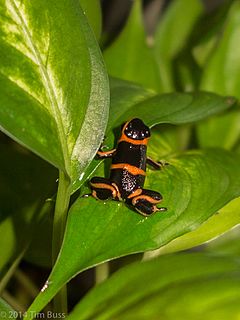
Ranitomeya summersi, sometimes referred to as Summers' poison frog, is a species of poison dart frogs found in the central Huallaga River drainage and adjacent Cordillera Azul National Park in central Peru. Before 2008, the species was considered a subspecies of Ranitomeya fantastica. The IUCN considers it an endangered species because of limited habitat range, habitat loss, and collection for the pet trade.

Ranitomeya benedicta, sometimes called the blessed poison frog, is a species of poison dart frogs found in the lowland rainforest of the Pampas del Sacramento in southern Loreto and eastern San Martín Region, northeastern Peru. Before 2008, the species was considered a subspecies of Ranitomeya fantastica. The IUCN considers the species vulnerable because of limited habitat range, habitat loss, and collection for the pet trade.
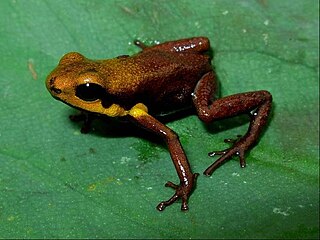
Andinobates tolimensis, the Tolimense poison frog, is a species of amphibian in the family Dendrobatidae, endemic to Colombia in the outskirts of Falan and north of the department of Tolima. Previously it was included in the genus Ranitomeya, but was reclassified in Andinobates, along with 11 other species. It is threatened by habitat loss. It is toxic to humans and when captured will excrete a milky substance.














